Field Guided
Nature has been a key theme in art since time. But with climate change and sustainability concerns mounting, today’s artists are looking at the plants around them with new urgency and intimacy. No longer mere still life, native plants are now integral elements of artists’ personal, cultural and environmental worlds. These seven young Texans are making work inspired by the beauty, diversity and resilience of the state’s botanical landscape.
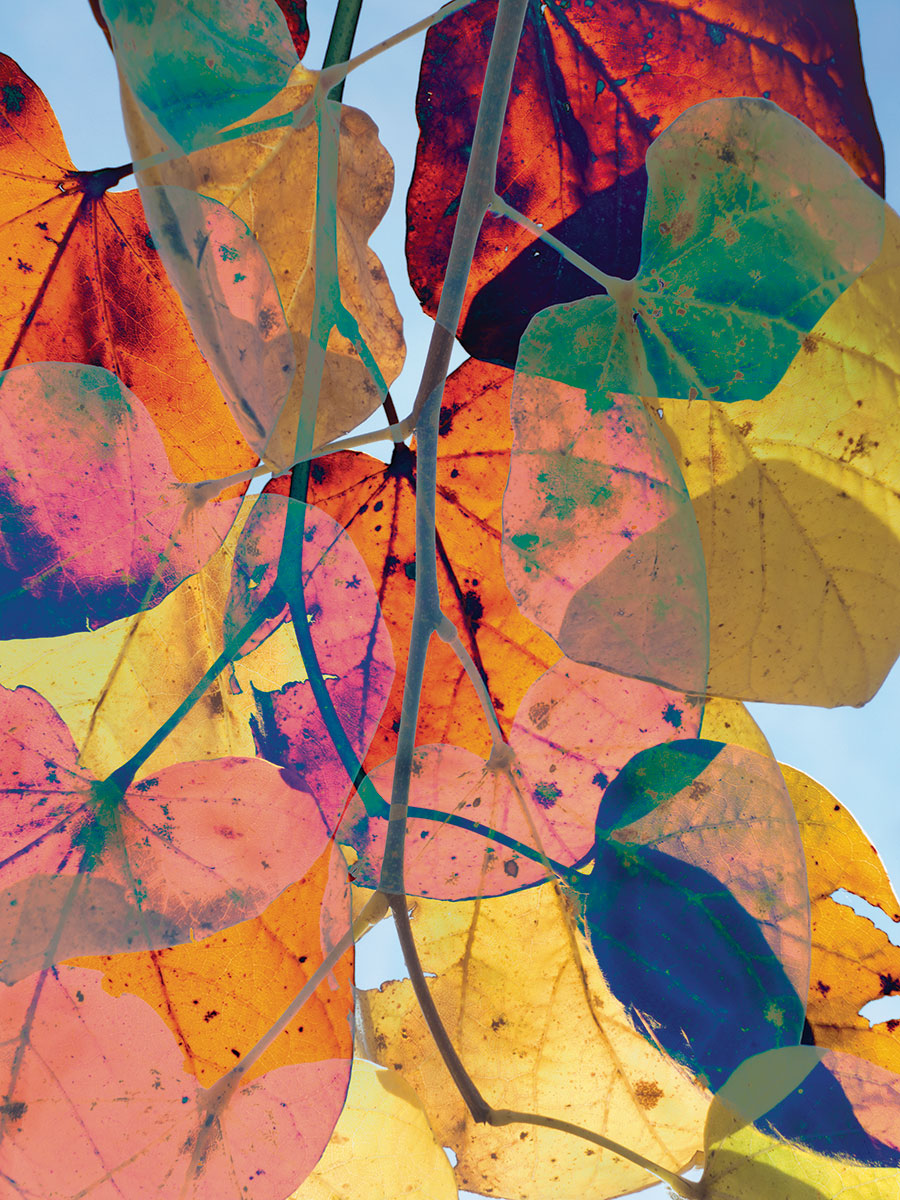
“Weave (Redbud),” 2018, photographic collage on rice paper IMAGE Elizabeth Chiles
Elizabeth Chiles – Photography & Collage
Sometimes something comes from nothing. During the drought that plagued Central Texas from 2010 to 2013, Elizabeth Chiles decided to explore how the lack of water was affecting the local landscape.
Her “Figs from Thistles” photographic series revealed that our native wild grasses, though parched and stiffened by drought, “still had incredible movement and texture,” she says. Even more surprising were the Texas wildflowers, particularly firewheel (Gaillardia pulchella) and prairie verbena (Glandularia bipinnatifida), still hanging on to life during the worst drought in over a century. For Chiles, those flowers were a symbol of hope that also hammered home the necessity of native plants for a sustainable Texas landscape.
Born in Austin and raised in Houston, Chiles spent much of her childhood outdoors. She describes her early days watching light filter through plants around her as “awakening both my senses and my mind.” Nowadays, that feeling of warmth, familiarity and transcendence is what Chiles hopes to convey through her artwork. To do that, “plants are the portal,” she explains. Her work captures grasses swaying, flowers reaching skyward, and branches bending as the plants respond to wind, drought and rain. Chiles shows the resilience and beauty of Texas flora as it struggles against increasing stress — a reminder of how close global environmental concerns hit to home.
After studying in New York City and San Francisco, Chiles returned to Texas in 2007, strengthening her connection to the local landscape. Her 2018 “On Water” series, for instance, traces historic flooding along Austin’s Colorado River in kaleidoscopic digital collages. Working in tandem with the weather patterns and growth cycles around her, Chiles incorporates herself into those ecological systems. “Flooding and drought have literally and spiritually changed the way I see the Texas landscape,” she says, and her work — which includes recognizable natives such as redbud trees (Cercis canadensis, above) and palmettos (Sabal minor) — is an ongoing testament to that change.
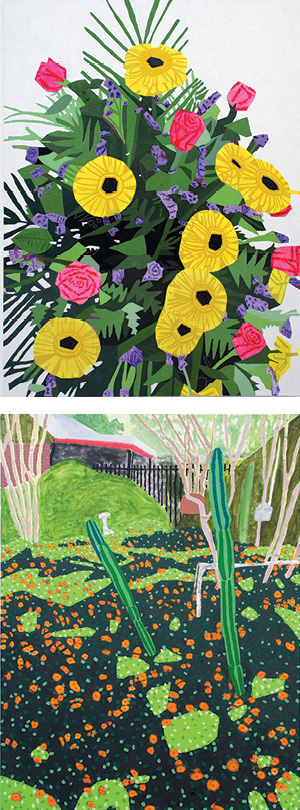
TOP “Lindale Park,” 2018, oil on canvas BOTTOM “Rosedale 3,” 2019, oil on canvas IMAGES Bradley Kerl
Bradley Kerl – Painting
Bradley Kerl’s connection to plants runs deep. A Beaumont native, the artist’s earliest memories are of riding on a tractor with his grandfather on the family farm. “The area where I grew up is basically tucked into the very bottom of the Big Thicket [National Preserve], along Pine Island Bayou,” Kerl says. “The soundtrack of my childhood definitely includes the gentle whir of wind through loblolly pines [Pinus taeda] and the clatter of palmettos [Sabal minor].” However, plants didn’t enter his own pictures until college, when he was studying at the University of North Texas in Denton.
In his bold, almost-abstract canvases, plants such as native cacti, common sunflowers (Helianthus annuus) and non-native philodendron become vibrant fields of color and funky shapes. Plants are Kerl’s perennial motif. “I find endless joy and fascination from being around plants,” he says, and it shows: There’s greenery in nearly every piece he paints. His work is also featured on two album covers for the band Ultimate Painting, which is often described as having a pastoral sound.
The artist works from live plants in his studio, along with found images and personal photographs of “all kinds of plants and plant-related stuff.” Kerl’s quirky sense of humor comes through in his still lifes, which depict an eclectic mix of native and exotic plants, artificial fruits, packaged products, and even the occasional human skull.
“I deal with native plants in my work simply because they are among the things I encounter on a daily basis,” Kerl explains. But they also form a diary of his experiences. In paintings of a loved one’s greenhouse, bridal bouquets and funeral sprays, plants represent key moments from Kerl’s life.
Based in Houston since 2011, Kerl takes great pride in being a native Texas painter. Through his artwork, he hopes to share the local landscape with a larger audience. And the plants aren’t only in his paintings: Now Kerl and his young family tend their own home garden as a way to spend time together outdoors. “I suppose it’s in my genes,” Kerl says, and his paintings say it too.
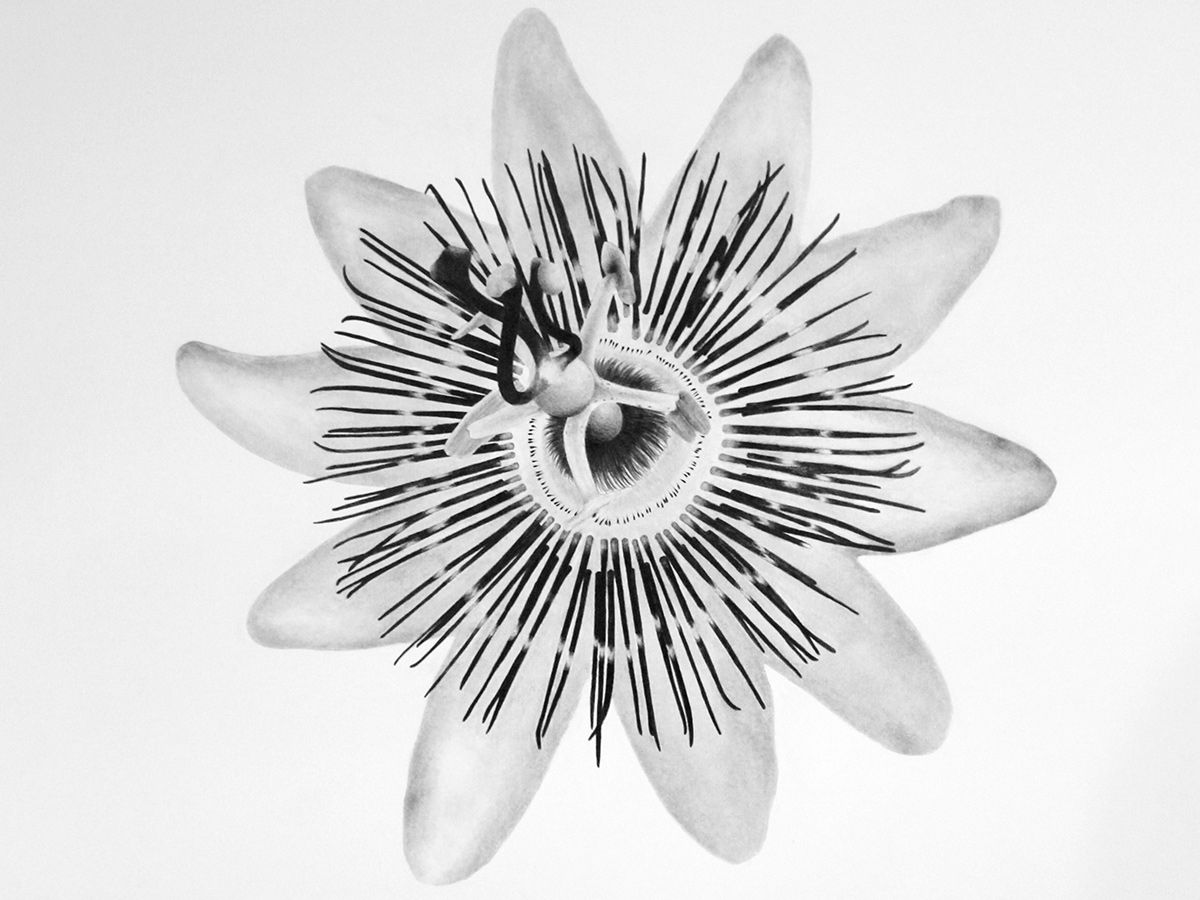
“Passionflower,” 2018, graphite on paper IMAGE Ashley Thomas
Ashley Thomas – Drawing
For Ashley Thomas, flowers are a sign of home. Growing up, her mother decorated their house with plastic flowers and floral wallpaper and fabrics. “That imagery is very connected with my memory of home,” Thomas says. But she also connects to flowers’ fleeting nature, noting, “Their ephemeral quality pairs well with the things that I choose to draw.”
Take her recent graphite illustration of a Texas passionflower (Passiflora foetida, above). At nearly two by three feet, Thomas’ picture freezes and enlarges the unusual bloom at its peak. The artist was interested in the medicinal qualities of the plant, which is thought to relieve anxiety and insomnia and was used by Native Americans to help heal wounds. She was also fascinated by the species’ Catholic symbolism — its common name, corona de Cristo, refers to Jesus’ crown of thorns.
Thomas had an early interest in plants and gardening and recalls her family’s vegetable patch fondly. Today, she has native edible plants such as chile pequin (Capsicum annuum) in her own garden along with Turk’s cap (Malvaviscus arboreus) and honey mesquite (Prosopis glandulosa). And for Thomas, plants are always in sight: She passes through her garden every time she travels from her house to her backyard studio.
Thomas studied in Chicago and lived in Austin before returning to her hometown of Corpus Christi in 2016. She was pulled back by the city’s coastal landscape and the vastness of the gulf. “When I think of Corpus Christi, I think of the horizon line,” Thomas says. The move has shaped her art practice too. “The drawings I make are formed out of the landscape I’ve grown up in,” she says, explaining that this landscape can be cultural or physical, interior or exterior.
Thomas’ black and white drawings cut out color and context to focus on intense detail and scale. The viewer is drawn in by soft gray tones and the artist’s steady hand. For a moment, we are as focused on her subject as she was while drawing it. That’s how Thomas gets us to pay attention to her world: It becomes our world too.
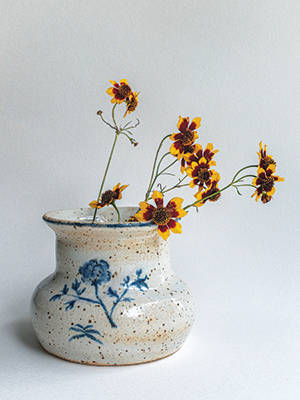
“Spring Vessel,” 2019, stoneware IMAGE Jessica Ninci
Jessica Ninci – Ceramics
Birds brought Jessica Ninci to plants. Earlier this year, the Galveston-based artist took an observation trip to High Island to research the spring migration patterns of native birds on the Texas Gulf Coast. The variety of native plants that she found there piqued her interest, and she decided to investigate the region’s flora through a new series of porcelain vessels.
Ninci had been thinking about humans’ impact on the natural world for a while, and she’d incorporated floral motifs into her ceramic pieces in the past. But the two lines of thought hadn’t fully come together until she took that birding trip. “I first saw my interest in plants and the landscape as separate from my artist practice, even as an escape,” she reflects. “I now see a connection forming and it’s enriching to my work.”
Since moving to the Texas Gulf Coast two years ago, Ninci and her partner, artist Dan Schmahl, have been turning the land around their Galveston home into a refuge for native plants such as Turk’s cap (Malvaviscus arboreus), coral honeysuckle (Lonicera sempervirens) and milkweed (Asclepias spp.). Once she started growing and documenting local varieties, Ninci experienced a heightened awareness of the native plants all around her. She began to spot whitemouth dayflower (Commelina erecta), firewheel (Gaillardia pulchella), beach primrose (Camissonia cheiranthifolia), powderpuff (Mimosa strigillosa), Texas frogfruit (Phyla nodiflora), coreopsis (Coreopsis spp.) and others in her yard and in the surrounding Galveston area.
“I had always seen them, but it’s amazing how much more you notice once you start growing them yourself,” she muses. Ninci’s “Native Plant Series” (sample, above left) spotlights these local plants and fuses her passion for ceramics, gardening and observing the natural world.
Along with their individual art practices, Ninci and Schmahl recently launched Rising Tide Projects, a creative community space sponsored by the Idea Fund. Inspired by Hurricane Harvey and the dangers of heavy rain, high tide and climate change, Ninci and Schmahl’s new space in historic downtown Galveston is architecturally adapted to extreme Gulf Coast weather. Here, they host public exhibitions and workshops that explore local environmental issues through art making. The space is also a printing press, and the duo collaborates with local Texas artists to publish limited-edition zines and art books.
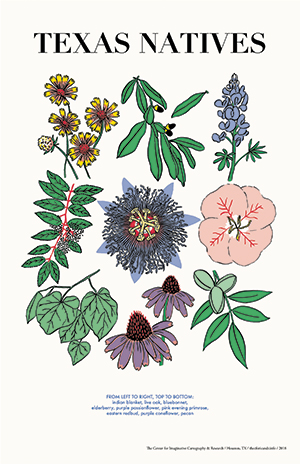
“Texas Natives,” 2015, Risograph print IMAGE Center for Imaginative Cartography and Research
Emily Halbardier & Erik Sultzer – Printmaking
Emily Halbardier and Erik Sultzer share a profound respect and appreciation for flora. “Plants offer us so much and ask so little in return,” they say. It’s a statement that guides much of their creative and personal lives. Halbardier and Sultzer met nine years ago as graduate students at the University of California, Santa Barbara, and have been working and living together ever since.
The duo’s collaborative project, the Center for Imaginative Cartography and Research, is a creative studio and printing press. Together they make works on paper, publish limited-edition art books, and teach art at a Houston-area high school.
Halbardier and Sultzer see these activities as part of their artistic and personal mission: to raise awareness about native Texas plants and environmental conservation. “We like native plants because they can sustain themselves without too much human intervention [and] are good for pollinators, birds and soil,” says Sultzer. “They are also part of what makes a place feel unique, and since our work involves mapping or documenting the world around us, native plants need to be included in that.”
True to their teaching vocation, the CICR’s “Texas Flora Series” (sample, above right) started as an educational tool. Separated into six categories — Texas natives, toxics, medicinals, invasives, illegals and edibles — the posters are informative and eye- catching. But they also refer to the “connection between language and the perception of a plant’s value (or lack thereof).” For example, the spiky ocotillo (Fouquieria splendens) has medicinal properties, while the showy angel trumpet (Datura wrightii), which sounds divine in name, is toxic if consumed.
The couple loves to spot evening rain lilies (Cooperia drummondii) and Texas frogfruit (Phyla nodiflora) while walking Houston’s Buffalo Bayou, and they grow native plants such as purple coneflower (Echinacea purpurea) and Texas sage (Leucophyllum frutescens) in their own garden.
Some of their strongest childhood memories involve plants. Halbardier, a Houston native, recalls “looking forward to when the Texas mountain laurel [Sophora secundiflora] was in bloom, so I could stop and smell the heavenly grape scent of the blossoms, watching birds devouring ripe American beautyberries [Callicarpa americana] in my mother’s garden, and making the yearly pilgrimage to the best patch of bluebonnets [Lupinus texensis].”
These cherished experiences continue to inform their passion for Texas plants. The CICR’s artworks and projects are Halbardier and Sultzer’s ever-evolving effort to protect the natural world around them.
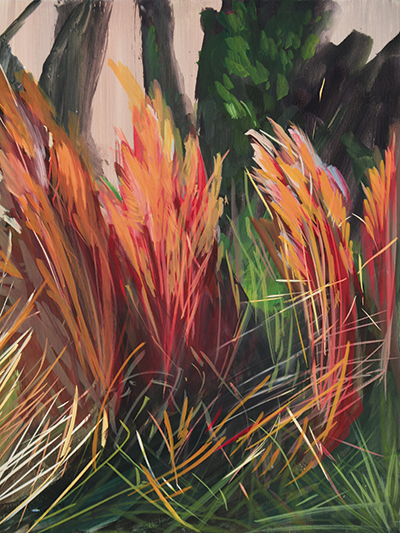
“Fall Plants,” 2016, acrylic paint on wood. IMAGE Courtesy of the artist
Erika Duque – Painting
For Erika Duque, native plants add a sense of place. Duque lives in Fort Worth but was born and raised in New York City. Although she grew up in America’s largest metropolis, Duque didn’t miss out on nature: Her childhood home was located between the Queens Botanical Garden and the Kissena Corridor Park. She says her parents also always kept their apartment filled with greenery. “I cannot imagine life without being surrounded by or caring for a nursery of plants,” the artist says. Duque associates her childhood and current homes with specific plants, native and introduced: Buttercups and trees such as apple, cherry and maple represent New York, while crepe myrtles, paddle cactus, succulents and tall bushy grasses bring North Texas to mind.
Duque’s paintings of flowers, bushes and trees buzz with energy and emotion. Plants are so important to her that she’s started painting what she calls “portraits” of them as a way to press pause on their growth and decay — to highlight a specific moment in their plant lives. Her subjects include her own houseplants, plants she keeps at her parents’ house, and plants that she sees around her neighborhood or along her usual Fort Worth commute.
“I have been collecting succulents, cactus and all sorts of plants for over a decade,” Duque says. Some of these were gifts from loved ones, and others are mementos from special moments in her life. “I feel like I have become familiar with them over the years and have seen them go through changes,” she says. Thanks to her portraits: “If they die, I am left with their memory.”
Duque exhibited a selection of her painterly but precise plant portraits at the Botanical Research Institute of Texas’ art gallery in 2018. One of these pieces (image at the very top) depicts a spider lily (Hymenocallis latifolia). “I spotted the spider lilies in Houston during a family trip. I loved their long tentacles and pointy, geometric look,” she says. Another canvas features bushy bluestem (Andropogon glomeratus, left). Duque saw it growing around the entrance of BRIT and was intrigued by its intense copper color and different textures. “I love plants that are odd or just have an interesting shape,” she says.
Beyond her plant portraits, Duque makes paintings and drawings of natural landscapes that she’s traveled to. Her pictures of geysers, forests and lakes focus on the feelings of awe and absorption that those places inspired in her. Using a combination of field notes, photographs and memories, Duque recreates a landscape’s essence through animated brushstrokes, brilliant colors and rich textures. The resulting scenes are otherworldly but sharply focused, painted with the urgency of someone capturing a dream they don’t want to forget.
Tornados, hurricanes, rainstorms and fires ravage Duque’s recent landscapes. Between smoking grounds and charred trees, it’s difficult to determine whether these disasters are natural, man-made or a combination of the two. The increasing volatility in the artist’s paintings conveys a lot about our current moment, when climate change and its impact on natural disasters looms large.
That uncertainty makes Duque’s artwork all the more compelling and vital. “It’s at the forefront of my mind and it’s hard not to feel helpless,” the artist laments. But her vivid, striking canvases continue to call attention to the landscapes that affect us most: our own.
Lauren Moya Ford is is a Texan artist and writer who grew up across the street from a greenbelt filled with native plants and wildflowers. Plant life is central to her art practice, which includes drawing, painting, photography and artist books. She currently works as an art writer based in Madrid, Spain. Her work is online at laurenmoyaford.com.
